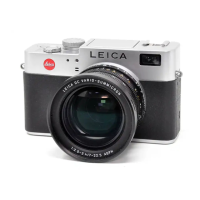Common Photographic Problems
While we have tried to anticipate the types of photog-
raphy you may encounter in the creation of this guide,
it is almost certain that you will run into situations
where what is happening with your captures simply
does not make sense.
After spending many hours with the Digilux 2, I have
collected a gallery of failed images. These images are
valuable as they indicate what went wrong based on
exposure, color balance, and other capture parameters
stored in each image file. When a picture is not suc-
cessful, you will learn quickly what settings to avoid,
and with some further testing, you will improve the
quality in future sessions under similar conditions.
Vibration
Often times you will take a picture that appears sharp
and bright on the display, only to find out after the fact
that the image is not sharp due to motion at capture.
I prefer to zoom into the image on the camera display
just to be sure that the focus is sharp. If an image
appears blurry in most cases this is caused by low light
levels in programmed auto exposure mode.
Suggestions:
•Adjust your ASA upwards i.e.: 100 to 200
•Switch to Shutter Priority automatic mode and set the
shutter speed at a speed that matches your lens focal
length. For example 60mm=1/60th sec.
•Use a wider angle lens setting (to minimize the effect
of motion)
•Try using the built-in Flash/Fill Flash
•Use a tripod or other camera support
•Place the camera on a stable surface and use the
self timer to trigger the exposure or use the optional
remote release cable.
When shooting in bright situations such as sand or snow
the images appear too dark
As discussed in the backlighting section earlier in this
guide, the camera’s meter is attempting to achieve
an ideal exposure balance. Since the camera sees a
predominance of light tones, it attempts to correct this
by biasing the exposure to a darker point. There are
several ways to compensate for this effect.
Suggestions:
•Use the EV button and the adjustment dial to add a
lighter bias to the auto exposure. A setting of +2 EV is
a good starting point. Going too far will result in blown
out highlights with no data.
•Use the Center weighted, or Spot metering modes to
help the camera meter expose the subject as opposed
to the background.
•If the above settings do not give you the desired
results try manual mode, but keep in mind that this
will generally require more time to verify exposures as
you go.
When shooting in dark situations such as night scenes,
the images look flat and too light
As discussed in the Night/Low Light section earlier in
this guide, the camera’s meter is attempting to achieve
an ideal exposure balance. Since the camera sees a
predominance of dark tones, it attempts to correct this
by biasing the exposure to a lighter point. There are
several ways to compensate for this effect.
Suggestions:
•Use the EV button and the adjustment dial to add
a darker bias to the auto exposure. 1 to 2EV darker
should work well. Going too far will result in too much
shadow density, and overall underexposure.
•Use manual mode, and bracket your exposures. Keep
in mind that this will generally require more time to
verify exposures as you go.
•Use raw mode to protect as much original data as
possible, as you may wish to fine tune the images in
Adobe® Camera Raw™ or Lasersoft Silverfast.
Note: When switching settings to compensate to spe-
cific situations it is a good practice to reset the camera
back to it’s normal settings when finished. I have
ruined a good number of images by leaving custom
camera settings in place.
The flash overpowers the ambient light
The built-in flash has been designed to provide even
exposure across the focal length of the built-in lens for
distances from approximately 3 to 10 feet. In situations
where ambient light is low, the background will go
dark. If the ambient light is near the exposure value of
the flash, a pleasing balance will be achieved. Balanc-
ing the two exposures may be challenging-especially at
dusk when the ambient light values will change rapidly.
There are several methods to compensate for the dif-
ference between the flash and ambient light.
•Try using the Flash EV control to lower the flash power
•Switch to aperture priority and select a wider aper-
ture
•Switch to full manual mode, and select a longer
exposure time (shutter speeds below 1/30th sec. will
begin to introduce a motion blur effect. You may also
experiment with the second curtain flash sync to alter
the effect of the flash portion of the exposure)
•Use the optional external flash unit
•Try the A-s Flash Mode which is optimized for use with
slower shutter speeds

